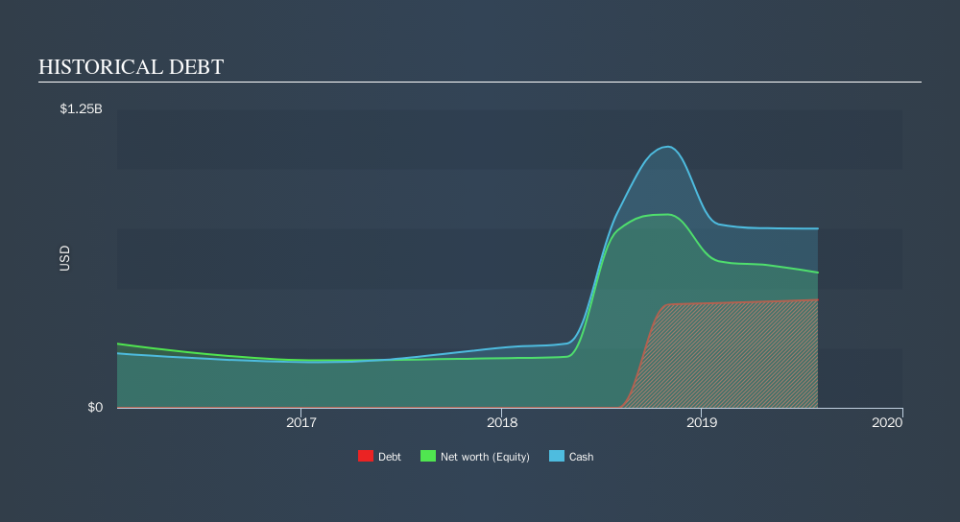Is DocuSign (NASDAQ:DOCU) Using Too Much Debt?

Some say volatility, rather than debt, is the best way to think about risk as an investor, but Warren Buffett famously said that 'Volatility is far from synonymous with risk. So it seems the smart money knows that debt - which is usually involved in bankruptcies - is a very important factor, when you assess how risky a company is. Importantly, DocuSign, Inc. (NASDAQ:DOCU) does carry debt. But should shareholders be worried about its use of debt?
Why Does Debt Bring Risk?
Debt assists a business until the business has trouble paying it off, either with new capital or with free cash flow. In the worst case scenario, a company can go bankrupt if it cannot pay its creditors. While that is not too common, we often do see indebted companies permanently diluting shareholders because lenders force them to raise capital at a distressed price. Having said that, the most common situation is where a company manages its debt reasonably well - and to its own advantage. The first step when considering a company's debt levels is to consider its cash and debt together.
Check out our latest analysis for DocuSign
What Is DocuSign's Net Debt?
As you can see below, at the end of July 2019, DocuSign had US$451.9m of debt, up from a year ago. Click the image for more detail. However, its balance sheet shows it holds US$750.3m in cash, so it actually has US$298.3m net cash.
How Healthy Is DocuSign's Balance Sheet?
The latest balance sheet data shows that DocuSign had liabilities of US$574.1m due within a year, and liabilities of US$621.0m falling due after that. Offsetting these obligations, it had cash of US$750.3m as well as receivables valued at US$154.2m due within 12 months. So its liabilities outweigh the sum of its cash and (near-term) receivables by US$290.7m.
Of course, DocuSign has a titanic market capitalization of US$10.9b, so these liabilities are probably manageable. However, we do think it is worth keeping an eye on its balance sheet strength, as it may change over time. While it does have liabilities worth noting, DocuSign also has more cash than debt, so we're pretty confident it can manage its debt safely. When analysing debt levels, the balance sheet is the obvious place to start. But ultimately the future profitability of the business will decide if DocuSign can strengthen its balance sheet over time. So if you want to see what the professionals think, you might find this free report on analyst profit forecasts to be interesting.
Over 12 months, DocuSign reported revenue of US$828m, which is a gain of 37%, although it did not report any earnings before interest and tax. Shareholders probably have their fingers crossed that it can grow its way to profits.
So How Risky Is DocuSign?
Although DocuSign had negative earnings before interest and tax (EBIT) over the last twelve months, it generated positive free cash flow of US$61m. So taking that on face value, and considering the net cash situation, we don't think that the stock is too risky in the near term. The good news for DocuSign shareholders is that its revenue growth is strong, making it easier to raise capital if need be. But we still think it's somewhat risky. When I consider a company to be a bit risky, I think it is responsible to check out whether insiders have been reporting any share sales. Luckily, you can click here ito see our graphic depicting DocuSign insider transactions.
If, after all that, you're more interested in a fast growing company with a rock-solid balance sheet, then check out our list of net cash growth stocks without delay.
We aim to bring you long-term focused research analysis driven by fundamental data. Note that our analysis may not factor in the latest price-sensitive company announcements or qualitative material.
If you spot an error that warrants correction, please contact the editor at editorial-team@simplywallst.com. This article by Simply Wall St is general in nature. It does not constitute a recommendation to buy or sell any stock, and does not take account of your objectives, or your financial situation. Simply Wall St has no position in the stocks mentioned. Thank you for reading.

 Yahoo Finance
Yahoo Finance 
